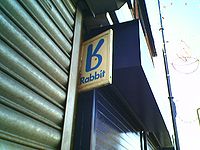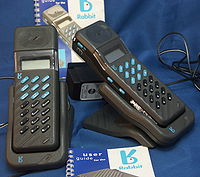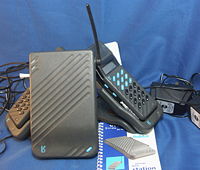
Rabbit (telecommunications)
Encyclopedia

United Kingdom
The United Kingdom of Great Britain and Northern IrelandIn the United Kingdom and Dependencies, other languages have been officially recognised as legitimate autochthonous languages under the European Charter for Regional or Minority Languages...
location-specific (Telepoint) telephone
Telephone
The telephone , colloquially referred to as a phone, is a telecommunications device that transmits and receives sounds, usually the human voice. Telephones are a point-to-point communication system whose most basic function is to allow two people separated by large distances to talk to each other...
service backed by Hutchison
Hutchison Telecommunications International Limited
Hutchison Telecommunications International Limited is a leading global provider of telecommunications services. The Group currently offers mobile and fixed-line telecommunication services in Hong Kong and Israel, and operates mobile telecommunications services in Indonesia, Vietnam, Sri Lanka and...
, who later went on to create the Orange
Orange SA
Orange is the brand used by France Télécom for its mobile network operator and Internet service provider subsidiaries. It is the fifth largest telecom operator in the world, with 210 million customers . The brand was created in 1994 for Hutchison Telecom's UK mobile phone network, which was...
GSM mobile network, followed by 3
Hutchison 3G
3 is a brand name under which several UMTS-based mobile phone networks and Broadband Internet Providers are operated in Australia, Austria, Denmark, Hong Kong, Macau, Indonesia, Ireland, Italy, Sweden, and the United Kingdom...
. The Rabbit network was the best-known of four such services introduced in the 1980s, the others being Phonepoint, Mercury Callpoint and Zonephone. Although Hutchison had been issued a licence for Rabbit in 1989, it took until May 1992 before the service was launched. Telepoint services such as Rabbit allowed subscribers to carry specially designed (CT2
CT2
CT2 is a cordless telephony standard that was used in the early 1990s to provide short-range proto-mobile phone service in some countries in Europe. It is considered the precursor to the popular DECT system...
) home phone handsets with them and make outgoing calls whenever they were within 100 metres of a Rabbit transmitter.
Rollout
The initial networkTelecommunications network
A telecommunications network is a collection of terminals, links and nodes which connect together to enable telecommunication between users of the terminals. Networks may use circuit switching or message switching. Each terminal in the network must have a unique address so messages or connections...
only supported outgoing calls but offered paging and messaging facilities as standard on all customer accounts. The service was rolled out after extensive tests with a thousand users and two thousand "base stations" located across the UK.
Original plans were for twelve thousand base stations to be placed around the UK by December 1992. The first service was launched in Greater Manchester
Greater Manchester
Greater Manchester is a metropolitan county in North West England, with a population of 2.6 million. It encompasses one of the largest metropolitan areas in the United Kingdom and comprises ten metropolitan boroughs: Bolton, Bury, Oldham, Rochdale, Stockport, Tameside, Trafford, Wigan, and the...
in May 1992 with the entire city centre of Manchester covered with Rabbit base stations. The service was then rolled out to the rest of the North of England and there was nationwide coverage in the autumn of 1993. At the height of Rabbit's operations they had twelve thousand base stations and ten thousand customers in the UK.
Closure

Vodafone
Vodafone Group Plc is a global telecommunications company headquartered in London, United Kingdom. It is the world's largest mobile telecommunications company measured by revenues and the world's second-largest measured by subscribers , with around 341 million proportionate subscribers as of...
, which also accepted incoming calls. The imminent conversion of these mobile phone networks to the modern-day GSM standard finished the conversation. Hutchison Whampoa
Hutchison Whampoa
Hutchison Whampoa Limited or HWL of Hong Kong is a Fortune 500 company and one of the largest companies listed on the Hong Kong Stock Exchange. HWL is an international corporation with a diverse array of holdings which includes the world's biggest port and telecommunication operations in 14...
lost around $183m from the failure of Rabbit but later went on to found the successful Orange
Orange United Kingdom
Orange is a mobile network operator and internet service provider in the United Kingdom, which launched in 1994. It was once a constituent of the FTSE 100 Index but was purchased by France Télécom in 2000, which then adopted the Orange brand for all its other mobile communications activities...
mobile phone network.
Wall-mounted signs advertising the Rabbit base stations are still visible in various parts of the UK some 17 years since the Rabbit service ended.
Home use
Many of the Rabbit CT2 telephones were sold with a home base station as a home CT2 cordless telephone system and these continued to be used for many years after the closure of the Rabbit network.


